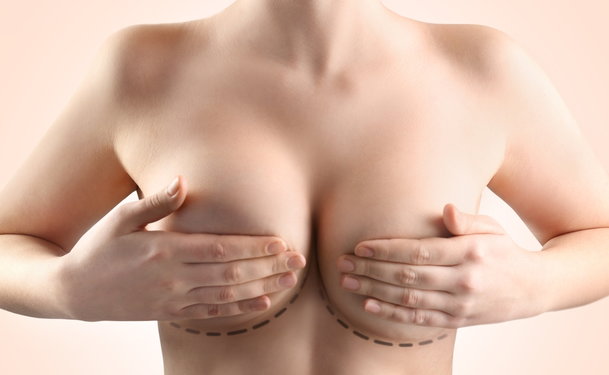Of all the breast implant incision placement options, the inframammary incision is the most popular. The inframammary incision is made along the breast crease under the breast.
If the incision is properly placed, the scar should not be visible, with the exception of being in a horizontal position. Your surgeon usually tries to situate the incision so that it will fall just above the inframammary fold. This is done in order to prevent the scar from being seen, for example, if your bathing suit top rides up. In small breasts, the incision may be placed initially below the crease, which will eventually blend with the IMF.
Your surgeon will estimate where the incision will be in relation to the new crease; otherwise, the scars could ride high on the breast and be very visible, or they could be placed too low, which would also make them visible.
Incision length will vary with choice of implant. Large implants and cohesive gel implants (gummy bear) may need longer incisions, whereas saline implants can be placed through very short incisions.
One advantage to this incision is that virtually all revisions, such as for capsular contracture, symmastia, bottoming out, etc., can all be performed via this incision.
If you have the transaxillary incision and need a revision due to a problem, chances are you will need to use a different incision, which means more scars on the breasts. If you start with the crease incision and have a problem, you will still end up with the two incisions you started with, instead of one or two new scars.
Periareolar vs inframammary incision: which is better?
The crease, or inframammary fold (IMF) incision is one of the most common incisions used for breast augmentation next to the periareolar. Like the nipple (areola) incision, this incision site will allow your implants to be placed over or under the muscle and allow for revisions, adjustments, and removal of breast implants without having to make a separate incision.
This incision pattern also allows your plastic surgeon to work within close proximity of your breasts, meaning more control over the placement of your implants. When using this incision, the implants do not pass through the breast ducts, which are known to harbor bacteria, and this has been found to decrease the rate of capsular contracture, or scarring around the breast implant.
Disadvantages of the inframammary incision
Crease, or IMF, incisions for breast augmentation are predictable and reliable, with very few disadvantages.
- One disadvantage is that the surgeon—in cases in which there is little breast tissue or little to no natural crease—has to estimate as to where to place the incision. However, experienced plastic surgeons are very good with this particular incision, and having a misplaced crease incision is rarely a problem.
- Another disadvantage is going up or down substantially in size. If you decide you want much larger implants, your crease may have to be lowered, though this is rare. This is done so that the implant can be centered behind the nipple. Going much bigger may mean that your incision scars from your previous surgery may be higher on the breast. The same rule applies to going smaller in size. If you go smaller, the crease may have to be raised, which means the incision scars will be lower than they were initially. However, this can be easily removed.
- If you decide to have your breast implants permanently removed, the crease incision will be visible, no matter what.
Reviewed By



